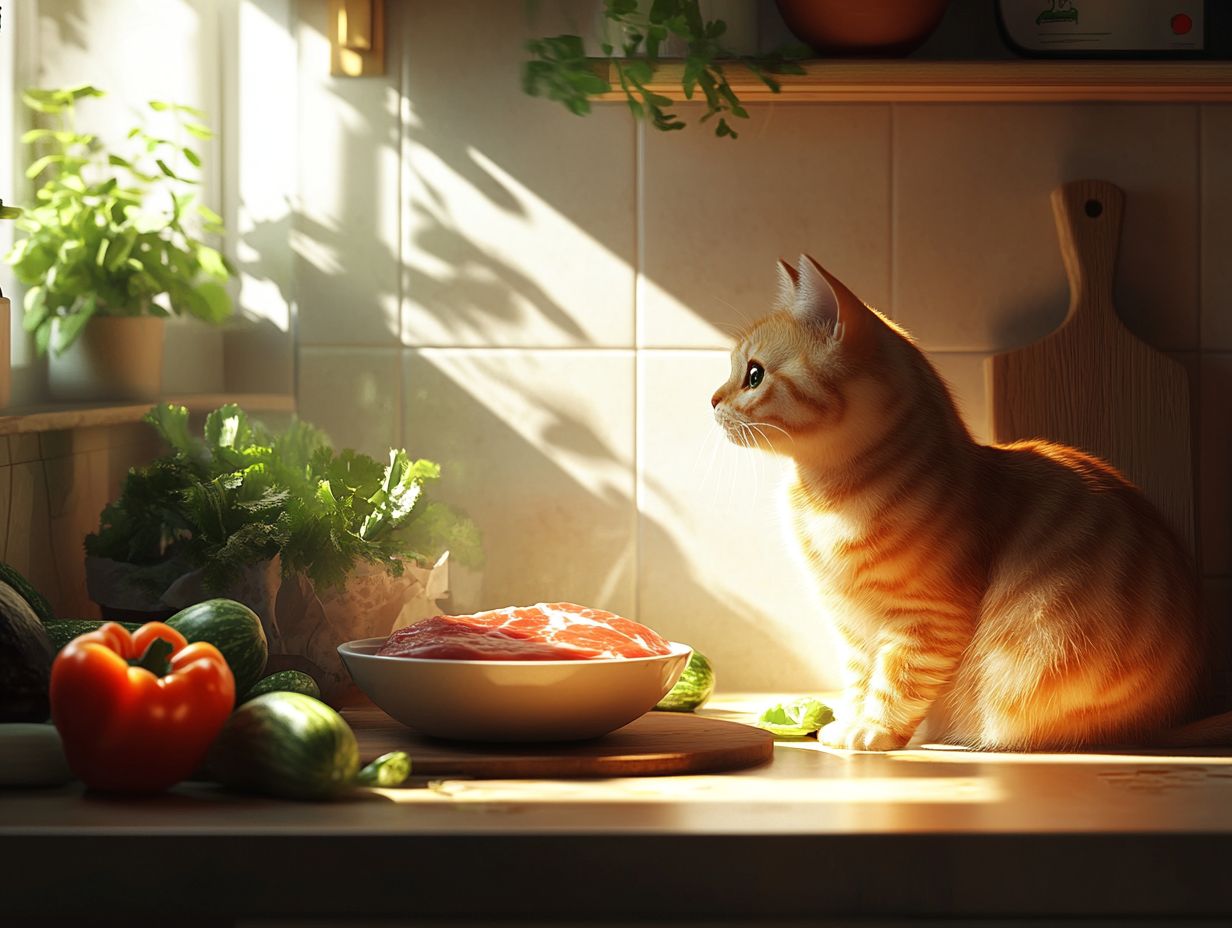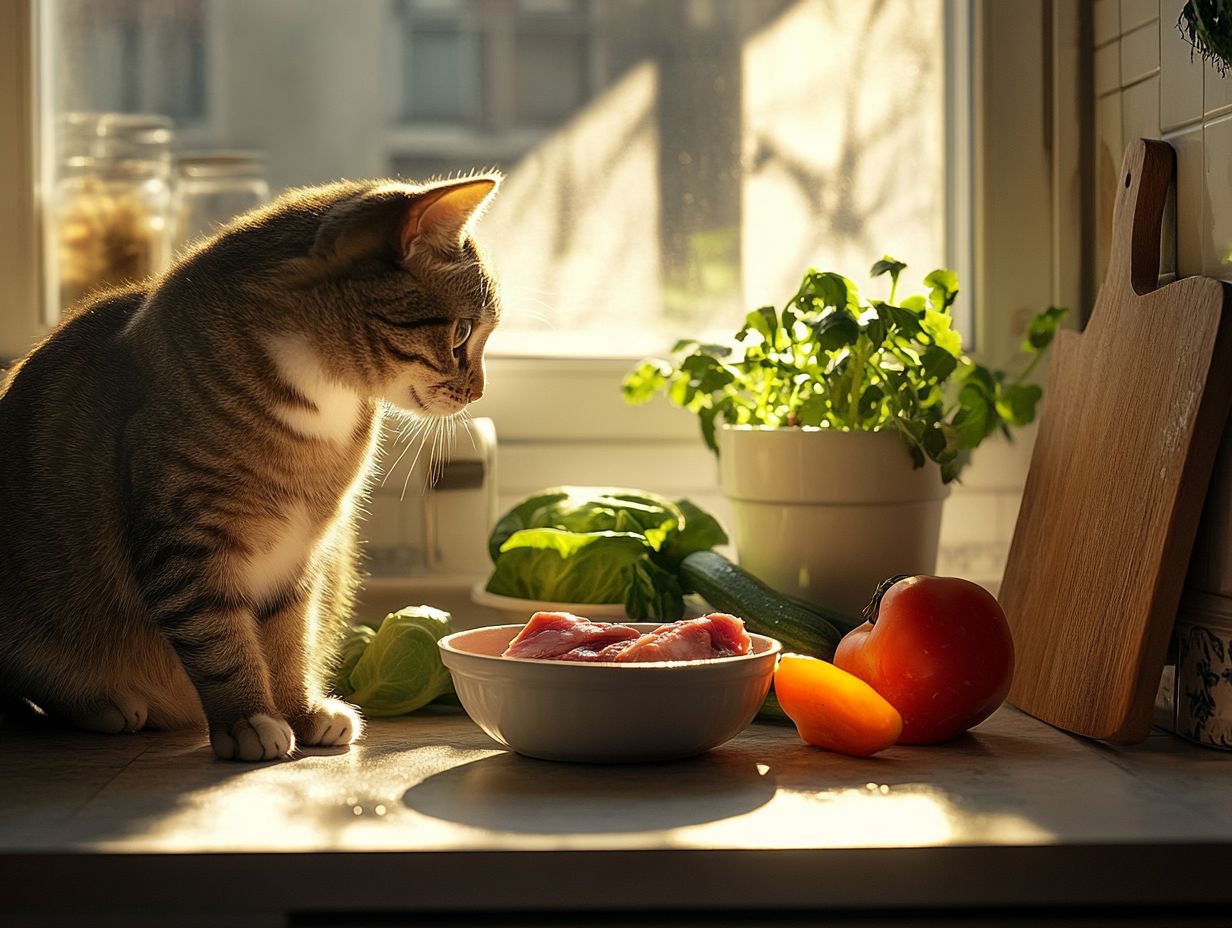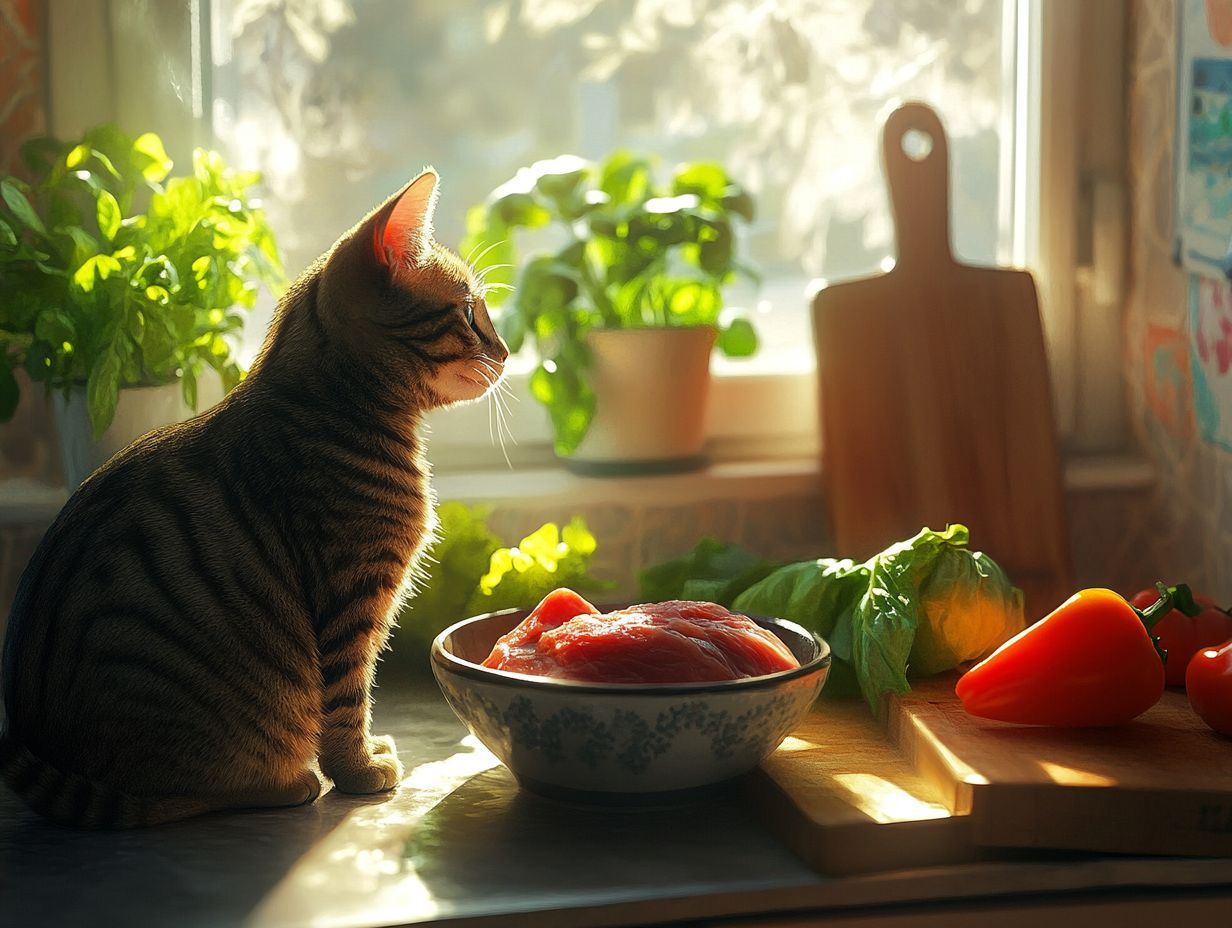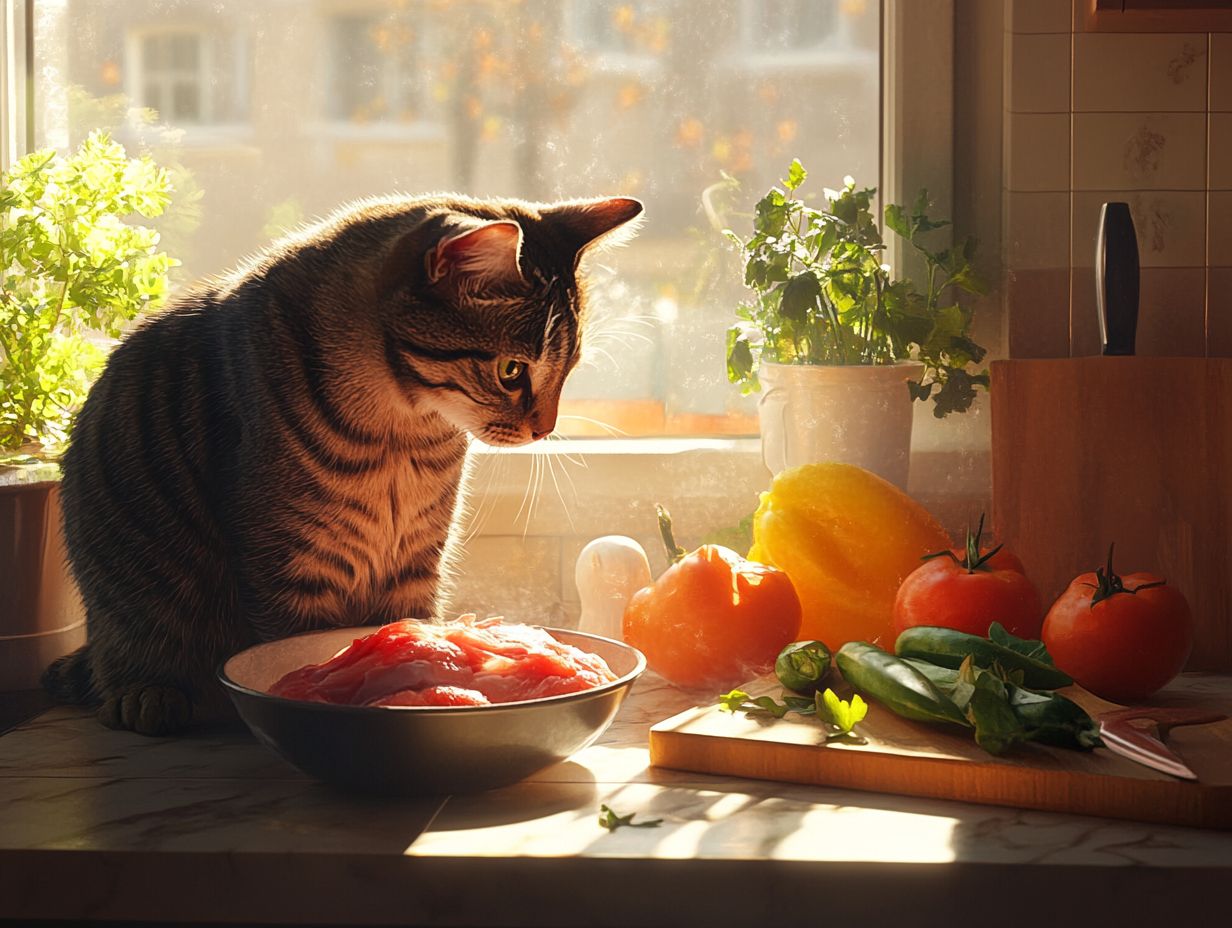Curious about the rising trend of raw food diets for cats? You’re not alone! Many pet owners are exploring how a raw cat diet can impact their feline friends’ health and well-being.
This article breaks down what a raw diet entails, its potential benefits, and the risks of raw meat. Essential tips for safely feeding your cat raw animal meat, including specific handling instructions and alternative nutritious options, will also be covered.
Join us as we navigate this complex yet fascinating topic to ensure your cat thrives.
Key Takeaways:

Raw Diet Basics
- Raw diets for cats involve feeding uncooked meat, bones, and organs.
- Benefits include improved nutrition and health, but potential risks include contamination and nutritional imbalances.
- To safely feed raw meat to cats, follow proper handling and preparation guidelines, and consider alternative nutritious diet options.
Understanding Raw Diets for Cats
Raw diets for cats are designed to provide a nutritionally dense option with high-quality protein sources, including raw animal meat from chicken, beef, and fish, as well as pork and venison.
You can enhance your cat’s diet by including these high-quality meats. A well-balanced raw food diet can effectively meet the dietary needs of carnivorous cats, especially when considering ingredient sourcing and following guidance from pet nutrition experts.
What is a Raw Diet?
A raw diet for cats consists primarily of raw animal meat, which serves as a key source of protein. These diets provide essential nutrients such as B12, iron, and taurine, all of which are crucial for your cat’s health and meet their nutritional needs.
Feeding practices associated with raw diets closely resemble those of wild felines, featuring a menu rich in animal-sourced protein, organ meats, and bones. Unlike traditional diets, raw diets do not rely heavily on processed ingredients or grain fillers, which often provide less nutritional value.
This emphasis on natural and unprocessed ingredients promotes optimal digestion and overall vitality for your cat. By considering your cat’s evolutionary dietary needs, you can provide a nutrient-dense diet that supports bone health, healthy skin, and a strong immune system, ultimately contributing to a better quality of life.
Benefits of a Raw Diet for Cats
A raw diet for cats offers several benefits, including improved coat condition, increased energy levels, and a reduction in health issues. This type of diet provides high-quality protein and essential vitamins that contribute to the overall wellness and vitality of felines.
Improved Nutrition and Health

The benefits of a raw diet for cats stem from the high-quality protein it provides, which is essential for your cat’s unique dietary needs and for achieving a balanced mix of nutrients necessary for optimal health. This protein plays a critical role in growth, tissue repair, immunity, and maintaining healthy skin. Raw food also contributes to improved digestion and vitality.
For instance, amino acids like taurine, found exclusively in animal proteins, are vital for heart and eye function. Additionally, vitamins such as B12 and minerals like zinc, present in raw food sources, are crucial for your cat’s vitality and overall well-being.
Therefore, a diet that includes a variety of real meats, organ meats, and some raw fruits or vegetables can be nutrient-dense, supporting muscle development and energy levels, which contribute significantly to your cat’s health and happiness.
Potential Risks of a Raw Diet for Cats
The potential risks associated with raw diets, including the dangers of raw meat, cross-contamination risks, and the presence of raw meat pathogens like Salmonella and E. coli, must be carefully weighed against the benefits. These factors can pose serious health risks to both cats and their owners.
Contamination and Nutritional Imbalance
Feeding your cat a raw diet poses serious risks related to contamination and nutritional imbalance. Improper handling of raw meats can lead to food safety concerns that negatively affect both the pet and the overall quality of the diet.
To minimize these risks:
- Always wash your hands after handling raw meat.
- Store raw meat in a separate container to avoid cross-contamination.
- For a 10-pound cat, start with 2-3 ounces of raw meat daily.
Before starting a raw diet, it’s crucial to consult with your veterinarian. Certain conditions, such as compromised immune systems, may make raw feeding inadvisable.
Understanding the benefits and risks of a raw diet is crucial for your cat’s health. Always consult with a veterinarian to tailor the best diet for your pet.
Consequences of these issues may include severe health complications, such as bacterial infections from Salmonella or E. coli. These bacteria can harm not only the cat but also pose significant risks to humans in the household, leading to symptoms like gastrointestinal distress. Additionally, a poorly balanced raw diet may lack essential nutrients, potentially resulting in further problems like obesity, dental issues, and weakened immune function. Immune system risks are particularly concerning for both pets and people.
To mitigate these risks, pet owners should adhere to strict guidelines, including sourcing high-quality ingredients, maintaining proper hygiene during preparation, and ensuring a balanced macronutrient profile to create a complete nutrient regimen. Regular veterinary checkups can help monitor the cat’s health and make necessary adjustments to their diet.
How to Safely Feed Raw Meat to Cats
To safely feed raw meat to cats, pet owners must follow strict hygiene practices for raw food. This includes sourcing the meat from high-quality suppliers and employing proper handling techniques to minimize the risk of contamination. It is advisable to consult a veterinarian for tailored advice to ensure safety.
Tips for Proper Handling and Preparation

Proper handling and preparation of raw meat for cats require adherence to food safety standards. This includes keeping raw meat separate from other food items and using sanitized utensils to prevent cross-contamination. Follow these steps:
- Wash your hands thoroughly with soap and water before and after handling raw meat.
- Clean surfaces that come into contact with the food using appropriate sanitizing agents.
- Designate specific cutting boards and utensils exclusively for raw meat.
- Store raw meat in the refrigerator at safe temperatures and serve it within 1-2 days.
- Inspect the quality and freshness of the meat before serving.
- A safe serving size is typically 2-4 ounces of raw meat per meal, depending on your cat’s weight and activity level.
Alternatives to Raw Diets for Cats
Alternative diets for cats, such as commercial diets and home-prepared diets, offer balanced nutrition that can be customized to meet their specific dietary needs while minimizing the risks associated with raw meat consumption.
Other Nutritious Diet Options
Other nutritious diet options for cats include both commercial and home-prepared meals, which can be formulated to provide a balanced diet. These diets ensure that essential nutrients and high-quality protein sources are included to support feline health. Cooked meats safety is often considered in these alternatives.
These diets can contribute to a well-rounded nutritional profile and are tailored to meet the specific needs of individual cats, whether they are kittens, adults, or seniors. Many commercial diets now offer specialized formulations that address various health concerns, such as weight management, dental health, or food sensitivities.
When comparing these diets to raw feeding, it is important to recognize that while raw diets can mimic a cat’s natural eating habits, they require careful preparation to prevent nutritional imbalances and foodborne illnesses.
By exploring both options, cat guardians can make informed decisions that prioritize their pet’s overall health and vitality, ensuring that dietary preferences align with their cat’s unique lifestyle. Following pet feeding recommendations from experts can help guide these choices.
Frequently Asked Questions
Can cats safely eat raw meat?

Yes, cats can safely eat raw meat as they are obligate carnivores, and their natural diet consists of raw prey.
What are the health benefits of feeding cats a raw meat diet?
A raw meat diet can provide cats with essential nutrients, enzymes, and amino acids that are often lost during the cooking process. It can also promote a healthier coat, improved digestion, and higher energy levels.
To ensure safe raw feeding, always prioritize hygiene, consult with a veterinarian for personalized advice, and consider balanced alternatives for your cat’s diet.
Benefits of a Raw Meat Diet
Feeding your cat a raw meat diet can provide various health benefits, but it is essential to ensure that the meat is sourced from high-quality suppliers. You should handle it with proper hygiene to avoid contamination. Always wash your hands and utensils after handling raw meat to prevent cross-contamination. The meat should be balanced with essential nutrients and supplements to support your cat’s overall health.
Can Raw Meat Diets Be Harmful to Cats?
Yes, if not balanced or handled properly, raw meat diets can be harmful to your cat. It is crucial to consult with a veterinarian and conduct thorough research before switching your cat’s diet to raw meat. You should also keep portion sizes in mind; a typical serving might be 2-3% of your cat’s body weight per day.
Risks Associated with Feeding Cats a Raw Meat Diet
There are potential risks when feeding cats a raw meat diet, including:
- Bacterial contamination (e.g., Salmonella)
- Nutritional deficiencies
- Choking hazards
It’s important to monitor your cat’s health and consult with a veterinarian if any issues arise.
Signs Your Cat May Not Be Tolerating a Raw Food Diet
If your cat experiences vomiting, diarrhea, weight loss, or lethargy after switching to a raw meat diet, your cat may be struggling with it. You should consult with a veterinarian to address any potential issues and make necessary adjustments to the diet. Keeping a feeding journal can help you track any changes in your cat’s health.
Conclusion
Always prioritize your cat’s health by balancing their diet and observing any changes closely. Before making substantial dietary changes, consult with a veterinarian to ensure your cat receives the best nutrition possible.